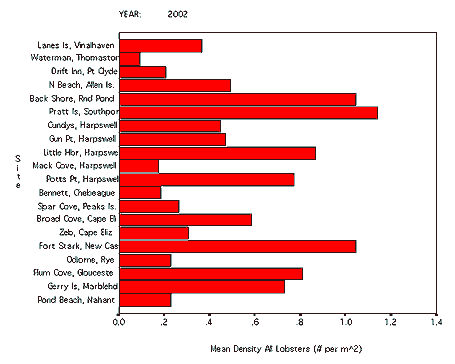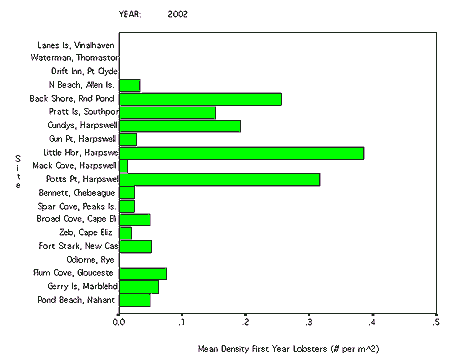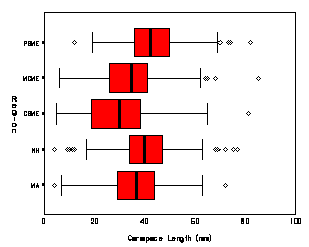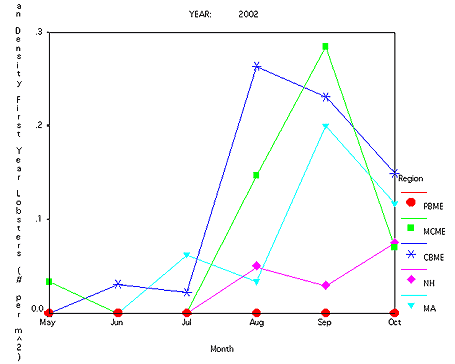
Sustaining a thriving lobster fishery through science and community.

Sustaining a thriving lobster fishery through science and community.
|
Juvenile Lobster Monitoring Program, 2002:Preliminary Reportby Sara L. Ellis and Diane F. CowanApril 2003Juvenile Lobster Monitoring Program, 2002
|

Figure 2a. Mean density of all lobsters at 20 sites sampled from May through October, 2002.

Figure 2b. Mean density of first year lobsters (< 17 mm CL) at 20 sites sampled from May through October, 2002.
By Region
The wide geographical range covered by volunteers allows us to look for patterns on a regional scale. Five regions represented in 2002 were Penobscot Bay (PBME), Midcoast Maine (MBME including Muscongus Bay and Southport), Casco Bay (CBME), New Hampshire (NH), and Massachusetts Bay (MA).
By region, mean carapace length ranged from 28.5 ± 0.64 mm CL (n = 459) in Casco Bay to 44.3 ± 1.41 mm CL (n = 80) in Penobscot Bay (Table 2; Fig. 3). Regions differed significantly in size-frequency distribution of lobsters (Kruskal-Wallis test, P < 0.001). Casco Bay ranked lowest, indicating that a higher proportion of more small lobsters were detected in this region than elsewhere (Fig. 3).
[ MISSING TABLE]
Table 2. Carapace length (CL) of lobsters at 20 intertidal sites in the Gulf of Maine by region, in 2002. (Regional abbreviations: PBME = Penobscot Bay, ME, MCME = Mid-Coast Maine; CBME = Casco Bay ME; NH = New Hampshire; MA = Massachusetts)

Figure 3. Size distribution of lobsters at 20 intertidal sites in the Gulf of Maine, 2002 (n = 1,126) by region. In these box plots the 25th, 50th, and 75th percentiles are shown by lines at the left, middle, and right of each box, respectively. The largest and smallest values that are not outliers are shown as thin horizontal lines; open circles show outliers (regional abbreviations as per Table 2).
To compare patterns of settlement among regions in 2002, we examined density of first year lobsters (< 17 mm CL). Except for Penobscot Bay, where no first-year lobsters were detected, abundance of first-year lobsters followed a strong seasonal pattern, and was generally highest in August and September (Figure 3). Densities of first year lobsters were highest in Casco Bay and Midcoast Maine (Figure 3).

Figure 4. Inter-regional comparison of mean density of first year lobsters (< 17 mm CL) at 20 intertidal sites in the Gulf of Maine, 2002 (regional abbreviations as per Table 2).
By Year
Long-term monitoring allows us to look for interannual patterns over time. The JLMP began in 1996 in Casco Bay, and expanded to other regions starting in 1998. It wasn’t until 2000 that all five regions were included in the study. Given that there are regional differences in carapace length and abundance (as noted above; also Ellis and Cowan 2001), we can only make interannual comparisons of CL for 2000-2002. Mean carapace length was significantly lower in 2002 than in the two previous years (Table 3), indicating that a greater proportion of small lobsters were found in 2002, which is corroborated by size frequency histograms (Figure 4). The higher proportion of small lobsters is suggests that 2002 was a strong year for settlement.
[ MISSING TABLE]
Table 3. Mean carapace length by year, in the JLMP 2000-2002 (n = 20 sites)
[ MISSING FIGURE]
Figure 5. Annual size frequency distribution of lobsters at 20 intertidal study sites in the Gulf of Maine, 2000-2002.
[ MISSING FIGURE]
Figure 6. Mean density of first year lobsters at 20 sites in the JLMP, 2000-2002.
Looked at as a whole, lobster settlement appears to have increased over the past 3 years, as indicated by increasing mean density of first year lobsters (Figure 6) in 201 and 2002 respectively.
However, on closer inspection, this pattern of increasing settlement was not true for all regions (Figure 7). Based on our sampling, it would appear that in Maine, settlement has trended downward in Penobscot Bay, but trended upward in Midcoast Maine and Casco Bay. In New Hampshire, settlement has trended upward, while in Massachusetts settlement has declined slightly between 2001 and 2002 (Figure 7).
[ MISSING FIGURE]
Figure 7. Mean density of recently-settled lobsters (grey bars) and first year lobsters (white bars) by year and by region, as determined by JLMP sampling between 1997 and 2002 (regional abbreviations as per Table 2).
Conclusions
The data collected by volunteers in the JLMP is valuable as it allows us to determine trends in the abundance of juvenile lobsters temporally and spatially. Preliminary results indicate that settlement was strong in 2002 in Midcoast Maine and Casco Bay, while settlement appears to be decreasing in the more northern and southern reaches of our studies, i.e. Penobscot Bay Maine, and Massachusetts Bay. The factors leading to the patterns have yet to be explored.
Acknowledgments
Special thanks are extended to the many volunteers who have participated in the Juvenile Lobster Monitoring Program, without whom this research would not be feasible. We are grateful for support from Bruce J. Anderson Foundation, the Community Fisheries Project of the Collaboration of Community Foundations for the Gulf of Maine, Darden Environmental Trust, Davis Conservation Foundation, Greater Piscataqua Community Foundation, Island Institute, Maine Community Foundation, Maine Department of Marine Resources, Maine Lobster Advisory Council, Maine Sea Grant, National Fish and Wildlife Foundation, Massachusetts Division f Marine Fisheries, New England Grassroots Environment Fund, New Hampshire Fish and Game, UpEast Foundation, and individual donors. Chris Brehme of the Island Institute prepared the map in Figure 1.
Literature cited
Cowan, D.F. 1999. Method for assessing relative abundance, size-distribution, and growth of recently settled and early juvenile lobster (Homarus americanus) in the lower intertidal zone. Journal of Crustacean Biology 19(4):738-751.
Cowan, D.F., S.L. Ellis, and J.R. Roundy. 2003. Field Handbook: Juvenile Lobster Monitoring Program. Published by The Lobster Conservancy, Friendship, ME. 65 pp.
Cowan, D.F., A.R. Solow, and A. Beet. 2001. Patterns in abundance and growth of juvenile lobster, Homarus americanus. Marine and Freshwater Research 52: 1095-1102.
Ellis, S.L. and D.F. Cowan. 2001. Volunteer-based monitoring of juvenile American lobster, Homarus americanus. Marine and Freshwater Research 52:1103-1112.
Solow, A.R., Beet, A., and Cowan, D.F. 2000. Optimal seasonal sampling for estimating an interannual trend. Israeli Journal of Zoology 46: 351–54.